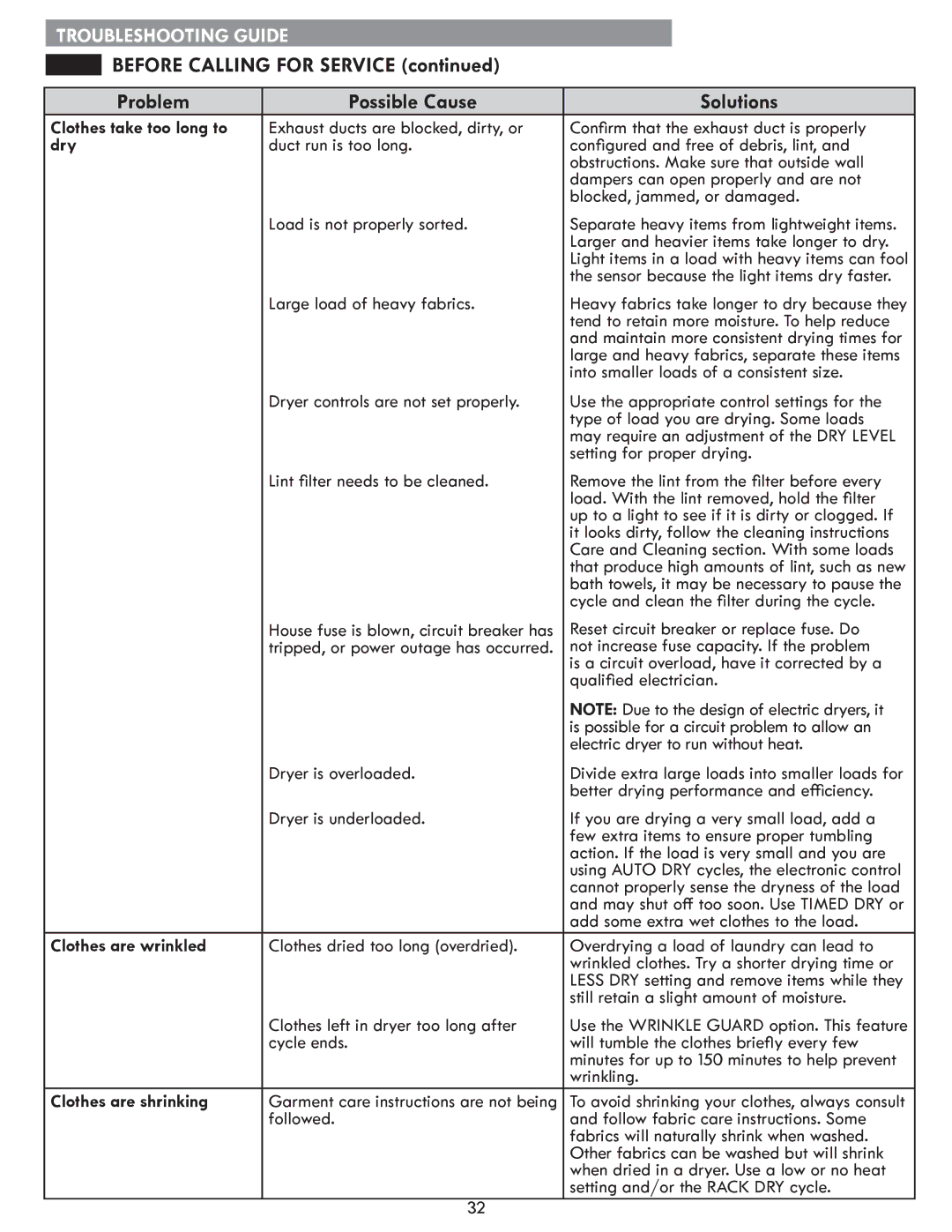
TROUBLESHOOTING GUIDE
 BEFORE CALLING FOR SERVICE (continued)
BEFORE CALLING FOR SERVICE (continued)
Problem | Possible Cause | Solutions |
Clothes take too long to | Exhaust ducts are blocked, dirty, or | Confirm that the exhaust duct is properly |
dry | duct run is too long. | configured and free of debris, lint, and |
|
| obstructions. Make sure that outside wall |
|
| dampers can open properly and are not |
|
| blocked, jammed, or damaged. |
| Load is not properly sorted. | Separate heavy items from lightweight items. |
|
| Larger and heavier items take longer to dry. |
|
| Light items in a load with heavy items can fool |
|
| the sensor because the light items dry faster. |
| Large load of heavy fabrics. | Heavy fabrics take longer to dry because they |
|
| tend to retain more moisture. To help reduce |
|
| and maintain more consistent drying times for |
|
| large and heavy fabrics, separate these items |
|
| into smaller loads of a consistent size. |
| Dryer controls are not set properly. | Use the appropriate control settings for the |
|
| type of load you are drying. Some loads |
|
| may require an adjustment of the DRY LEVEL |
|
| setting for proper drying. |
| Lint filter needs to be cleaned. | Remove the lint from the filter before every |
|
| load. With the lint removed, hold the filter |
|
| up to a light to see if it is dirty or clogged. If |
|
| it looks dirty, follow the cleaning instructions |
|
| Care and Cleaning section. With some loads |
|
| that produce high amounts of lint, such as new |
|
| bath towels, it may be necessary to pause the |
|
| cycle and clean the filter during the cycle. |
| House fuse is blown, circuit breaker has | Reset circuit breaker or replace fuse. Do |
| not increase fuse capacity. If the problem | |
| tripped, or power outage has occurred. | is a circuit overload, have it corrected by a |
|
| qualified electrician. |
|
| NOTE: Due to the design of electric dryers, it |
|
| is possible for a circuit problem to allow an |
|
| electric dryer to run without heat. |
| Dryer is overloaded. | Divide extra large loads into smaller loads for |
|
| better drying performance and efficiency. |
| Dryer is underloaded. | If you are drying a very small load, add a |
|
| few extra items to ensure proper tumbling |
|
| action. If the load is very small and you are |
|
| using AUTO DRY cycles, the electronic control |
|
| cannot properly sense the dryness of the load |
|
| and may shut off too soon. Use TIMED DRY or |
|
| add some extra wet clothes to the load. |
Clothes are wrinkled | Clothes dried too long (overdried). | Overdrying a load of laundry can lead to |
|
| wrinkled clothes. Try a shorter drying time or |
|
| LESS DRY setting and remove items while they |
|
| still retain a slight amount of moisture. |
| Clothes left in dryer too long after | Use the WRINKLE GUARD option. This feature |
| cycle ends. | will tumble the clothes briefly every few |
|
| minutes for up to 150 minutes to help prevent |
|
| wrinkling. |
Clothes are shrinking | Garment care instructions are not being | To avoid shrinking your clothes, always consult |
| followed. | and follow fabric care instructions. Some |
|
| fabrics will naturally shrink when washed. |
|
| Other fabrics can be washed but will shrink |
|
| when dried in a dryer. Use a low or no heat |
|
| setting and/or the RACK DRY cycle. |
| 32 |
|
